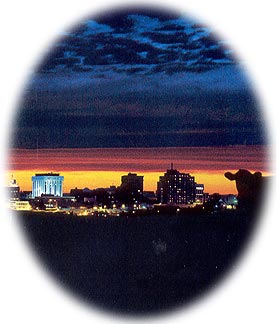Kansas City, Kansas

There's a place on the northeast border of Kansas where the Missouri River meets the Kansas River. A place where rivers join and cultures merge. Arts and entertainment cross paths. And, some of the most fascinating parts of America's past unite with the present, here in Kansas City, Kansas, in Wyandotte County.
One of the oldest farmhouses in Kansas still stands near the shores of the Kansas River. A rare American Indian dugout canoe now sits on dry land, a museum treasure for all to see.
The colorful seasons of Kansas City, Kansas, bring folks together for festivals and unforgettable traditions all year long. Arts, crafts, music, dance and folklore blend with modern fun. A NASCAR stock car track brings Winston racing fans, near and far. An outdoor amphitheater attracts top performing artists like Wynonna, James Taylor, Pearl Jam and Michael Bolton.
The past for Kansas City, Kansas is one of rich ethnic culture. Memories of the 18th century European, African, and Central American immigrants, the stockyards, the railroads, good times for America's farmers and the traditions of the American Indians are lived out each year in Kansas City Kansas through its many festivals, its monuments and its historic sites.
History
The town of Wyandot was incorporated in 1858. It was located in what now is the downtown area of Kansas City, Kansas. Wyandotte County continued to grow in its early days. By 1870, it had more than 10,000 people. It was during this period that Kansas City, Kansas became a railhead and received more than 120,000 head of cattle its first year.By the 1880s, population had grown to about 20,000. A real estate agent led in the effort of consolidate. In 1886, the cities of Wyandot, Armourdale, Armstrong and Kansas City, Kansas, were consolidated into one city� called Kansas City, Kansas. In 1890, the city had a population of more than 54,000 and more than 73,000 in 1900. In 1909 the City of Argentine became part of Kansas City, Kansas. The City of Rosedale was added in 1922.
Industry has always been important to Kansas City. Railroads and the stockyards can trace it roots to the 1870s. In the early 1900s, several meat-packing houses were established near the banks of the Kansas River. Many immigrants from Slavic nations came here to work in the packing plants. Most of the original white settles were of English and Irish descent.
In the late 1870s and the early 1880s, many black persons came to Wyandotte County. They were called the "Exodustors" who migrated from southern states after the Civil War. The railroads brought Mexicans to Wyandotte County. In more recent years, there has been a substantial increase in Mexican immigrants along with several persons from Southeast Asia.
